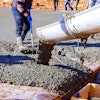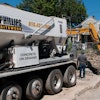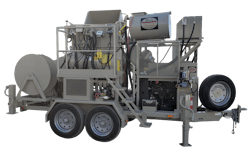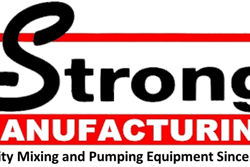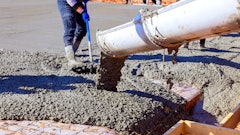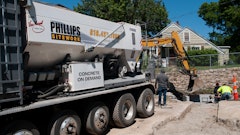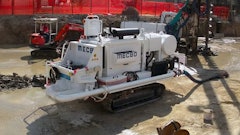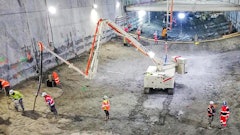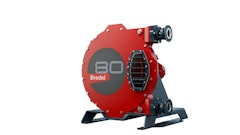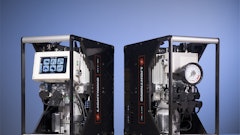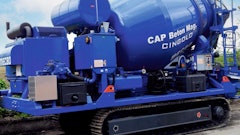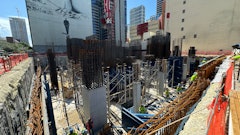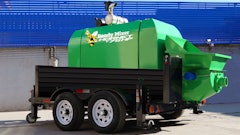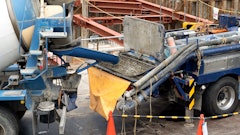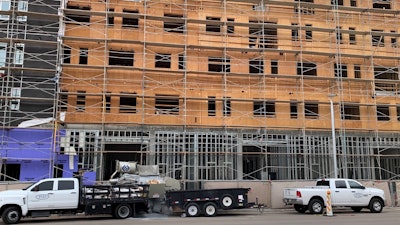
Founded in 1955, Paul Johnson Drywall Inc. (PJD) is considered one of the largest specialty contractors in the U.S. They work strictly in the residential space with locations across the country in Arizona, Tennessee, Utah, Nevada, and most recently in Denver. The PJD team plans to announce their entrance into Orlando in early spring 2022.
Their core business is installing drywall with 60% of the business in single-family residential and 40% in multifamily. Historically hey do roughly 8,000 single-family and 6,000 multi-family units in a year which they anticipate doubling with their entrance into Orlando. In PJD’s multifamily component of the business, they install gypsum underlayment and use a pump to move the material where it needs to be – running the job safer, saving time, and avoiding a lot of manual labor.
Where traditional concrete is portland cement based, gypsum underlayment is a gypsum-based concrete that is lighter weight. Utilized for fire and sound mitigation, gypsum underlayment has been around for about 30 years for all multi-story wood-frame buildings for the second to fifth floors. It’s also used to level podiums on commercial projects like high-end high-rise projects to support tile flooring.
After being asked about it for years, Paul Johnson Drywall Inc. started placing gypsum underlayment around 2016. “There’s a couple of anomalies, but almost every market that we've identified has maybe only two key gypsum underlayment players,” says Austin Johnson, Managing Director of Paul Johnson Drywall Inc. When schedules don’t line up perfectly, without self-performing the service, any missed days can set the job back. If they’re not available to return, with such a limited segment of service providers it can be a month or more until the job can continue.
“It’s gotten to where all of our jobs were being improperly sequenced to accommodate the underlayment side,” says Johnson. The company ended up spending too much time demobilizing workers and redoing schedules to accommodate the change – they needed to be more efficient. “But then our guys actually came to us and said, ‘Hey, we have to start doing this, it would be easier, faster and more efficient for us to put the product down ourselves than to, redo our sequencing every week.”
PJD uses a rear-loading pump for downtown work and owns three side-load pumps for suburban apartments. The rear-loading style allows them to need only a single lane of traffic instead of the entire street. They’ve purchased all four from Arkansas-based Strong Manufacturing.
They anticipate the Orlando expansion to double the company’s book of business and purchased a fifth machine, again from Strong – specifically the Placer model. Strong actually had PJD’s new Placer model on display at World of Concrete 2022 which received a good amount of expected attention. Johnson says that they’ve signed some new jobs for their Nashville location and are working on purchasing another for that market. Their strategy has been to order a new machine when they start a new market and get work signed up.
With any piece of equipment, you will have downtime for maintenance. Anticipating this, they’ll run two full-time pumps. “Instead of us losing any downtime, we are able to switch into a new piece of equipment the next day and not lose downtime with production,” says Johnson. So far, they’ve not had any major issues with the equipment, but the lifespan of any machine can vary between markets; different aggregates can cause wear sooner than others. But this isn’t something a manufacturer like Strong can fix as it's solely related to the quality of sand.
Strong Manufacturing’s Placer model features a John Deere industrial diesel engine with full digital instrumentation, hydrostatic transmission, as well as a hydraulic lift system. The mobile batch plant combines a patented double-drum mixer with Strong’s signature chrome-plated #100 pump capable of moving over 9,000 sq. ft. of slurry per hour. Jesse Downs, sales representative at Strong Manufacturing says that the machine has been in the field for 45 years—a testament that the Placer’s design can stand the test of time. The company manufactures all parts in-house, he explains. “[This] gives each customer the option of customizing each unit to their preference.”
When looking for your own, Johnson’s advice is to know your business and what your goals are. For them and their multifamily housing projects, the larger equipment seems to be the right fit to balance the size to production. You might not find the same efficiency with a smaller machine. “If you’re running 12 to 14 pallets in a day, you’re looking at a 10- or 11-hour day for your guys—plus drive time. Or you can do it with the Placer and do it in eight hours,” says Johnson.
To put it in a different way, consider paying six guys, multiple hours a day of overtime or pay for the better pump with a better production rate and potentially eliminate the overtime component. Finding that balance allows Johnson’s team to be fresher the next day. “We want our guys to be crisp and healthy. Monetarily, it’s beneficial for us to eliminate the overtime component but it’s also just keeping these guys healthy and fresh throughout their entire week versus burning them up.”
The company also finds that a larger-sized pump allows them to reach higher heights versus a lower tier pump which would limit your ability to pump vertically. With 40% of the company’s business in multi-story, multi-family buildings, the ability to send the material to the top floor just as fast as you can to the second provides a significant advantage to productivity. Johnson says that most of these buildings are five to eight stories. “You can only frame five stories of wood,” he explains, “but a lot of times they’ll do two or three floors of podium and frame five stories on top.”
Of course, an underlayment pump machine like those from Strong is only one way to get the gypsum to the upper floors – contractors could use a drum and mix it by hand or haul it up by crane but production will be a lot less and you will wear out employees going up and down stairs, as well as increasing concerns in safety.
Recently, Paul Johnson Drywall completed a job for Arizona State University, a six-story student housing complex project in downtown – very limited access. They were able to use the rear-loading Placer, parked on the street and put in line with the sand and moved material all day long needing to only block one lane of traffic for a few hours instead of both lanes for the entire day. “The university really appreciated not having their traffic blocked for all day,” Johnson says.
It's about safety he adds. “Anytime you have to block traffic, your chance of an accident occurring is very high. PJD is able to mitigate our risk by utilizing a pump that only requires us to block one lane of traffic.”
To be able to choose the right piece of equipment for your goals and needs, Johnson’s suggestions are to understand the requirements of the product type you’re getting into. “[Figure out] that what you are doing what pays, and what piece of equipment best serves that need,” he says.
“It’s a difference in what your focus is, what equipment properly aligns with your business needs because there are drastic differences in the options.”



